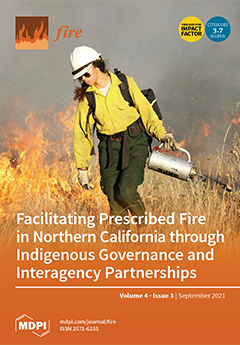The summer season of 2019–2020 has been named Australia’s Black Summer because of the large forest fires that burnt for months in southeast Australia, affecting millions of Australia’s citizens and hundreds of millions of animals and capturing global media attention. This extensive fire season has been attributed to the global climate crisis, a long drought season and extreme fire weather conditions. Our aim in this study was to examine the factors that have led some of the wildfires to burn over larger areas for a longer duration and to cause more damage to vegetation. To this end, we studied all large forest and non-forest fires (>100 km
2) that burnt in Australia between September 2019 and mid-February 2020 (Australia’s Black Summer fires), focusing on the forest fires in southeast Australia. We used a segmentation algorithm to define individual polygons of large fires based on the burn date from NASA’s Visible Infrared Imaging Radiometer Suite (VIIRS) active fires product and the Moderate Resolution Imaging Spectroradiometer (MODIS) burnt area product (MCD64A1). For each of the wildfires, we calculated the following 10 response variables, which served as proxies for the fires’ extent in space and time, spread and intensity: fire area, fire duration (days), the average spread of fire (area/days), fire radiative power (FRP; as detected by NASA’s MODIS Collection 6 active fires product (MCD14ML)), two burn severity products, and changes in vegetation as a result of the fire (as calculated using the vegetation health index (VHI) derived from AVHRR and VIIRS as well as live fuel moisture content (LFMC), photosynthetic vegetation (PV) and combined photosynthetic and non-photosynthetic vegetation (PV+NPV) derived from MODIS). We also computed more than 30 climatic, vegetation and anthropogenic variables based on remotely sensed derived variables, climatic time series and land cover datasets, which served as the explanatory variables. Altogether, 391 large fires were identified for Australia’s Black Summer. These included 205 forest fires with an average area of 584 km
2 and 186 non-forest fires with an average area of 445 km
2; 63 of the forest fires took place in southeast (SE) Australia (the area between Fraser Island, Queensland, and Kangaroo Island, South Australia), with an average area of 1097 km
2. Australia’s Black Summer forest fires burnt for more days compared with non-forest fires. Overall, the stepwise regression models were most successful at explaining the response variables for the forest fires in SE Australia (
n = 63; median-adjusted R
2 of 64.3%), followed by all forest fires (
n = 205; median-adjusted R
2 of 55.8%) and all non-forest fires (
n = 186; median-adjusted R
2 of 48.2%). The two response variables that were best explained by the explanatory variables used as proxies for fires’ extent, spread and intensity across all models for the Black Summer forest and non-forest fires were the change in PV due to fire (median-adjusted R
2 of 69.1%) and the change in VHI due to fire (median-adjusted R
2 of 66.3%). Amongst the variables we examined, vegetation and fuel-related variables (such as previous frequency of fires and the conditions of the vegetation before the fire) were found to be more prevalent in the multivariate models for explaining the response variables in comparison with climatic and anthropogenic variables. This result suggests that better management of wildland–urban interfaces and natural vegetation using cultural and prescribed burning as well as planning landscapes with less flammable and more fire-tolerant ground cover plants may reduce fire risk to communities living near forests, but this is challenging given the sheer size and diversity of ecosystems in Australia.
Full article





